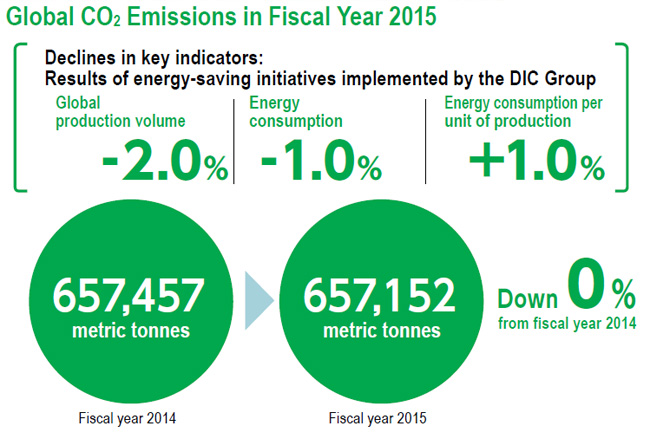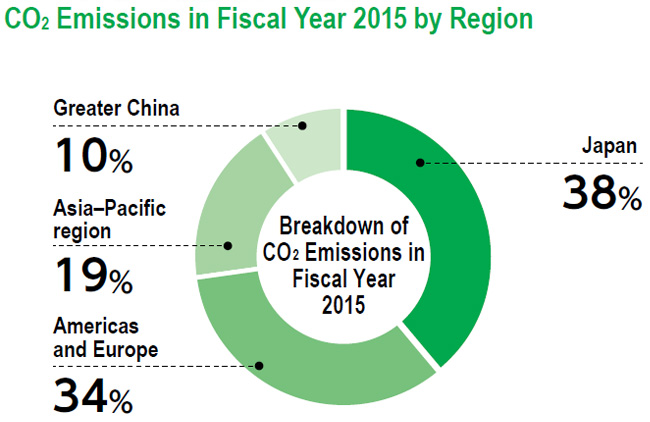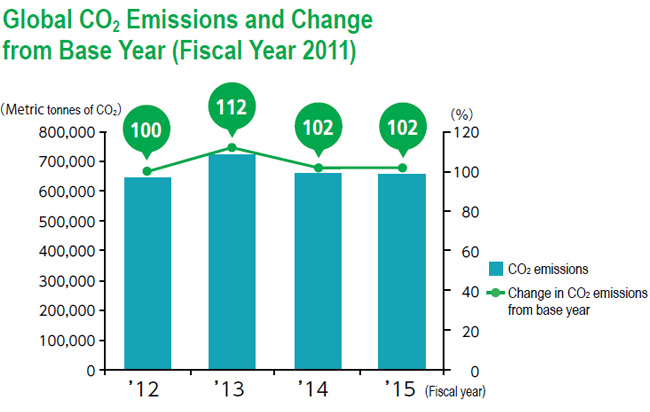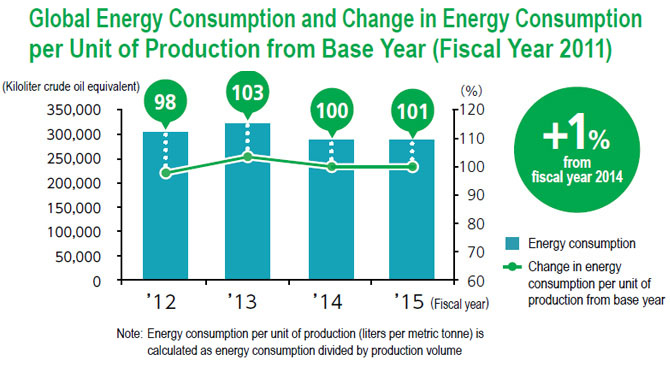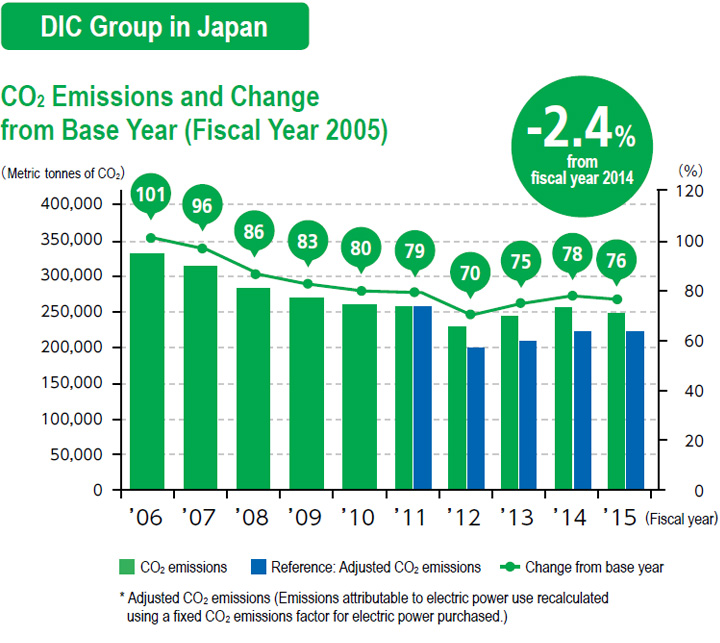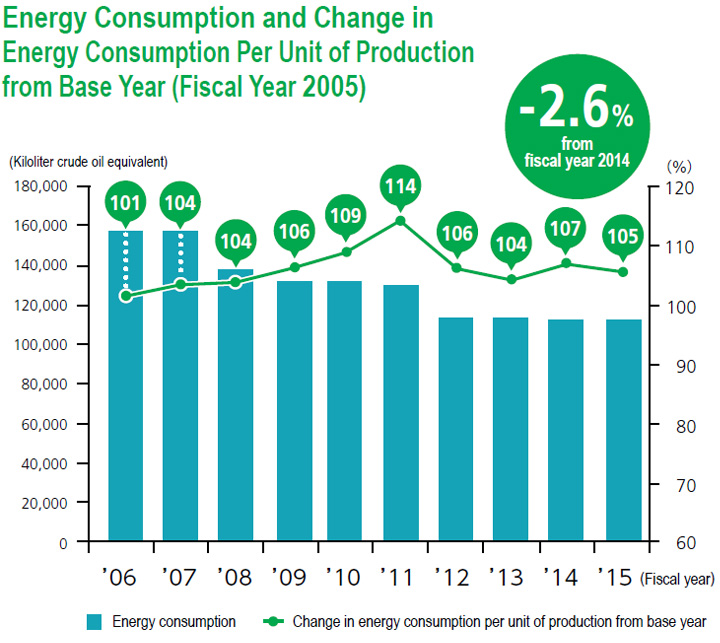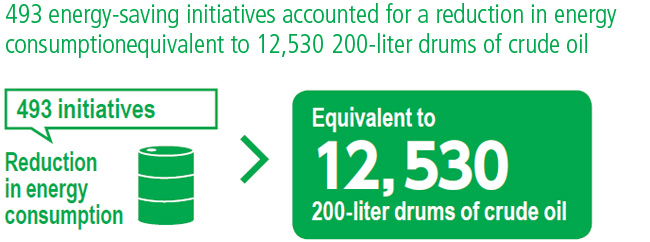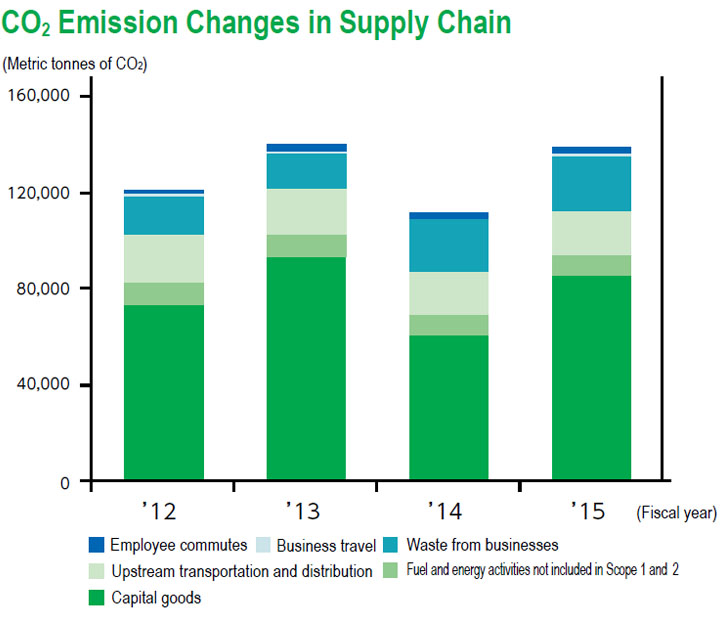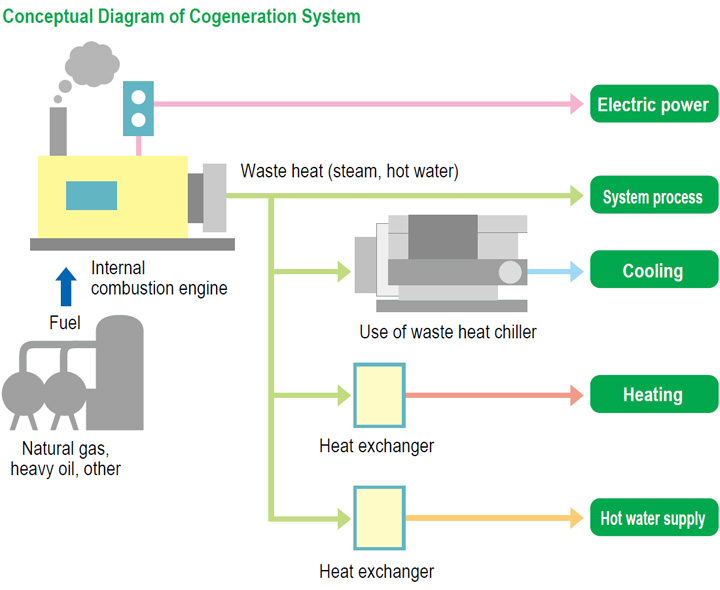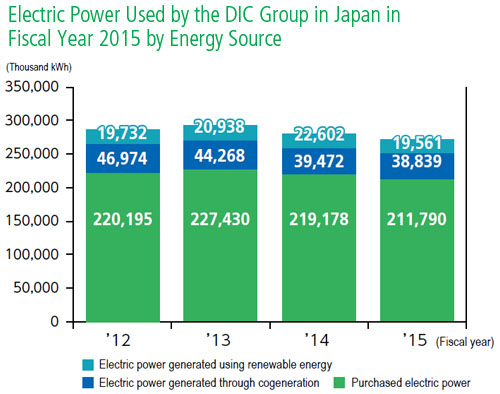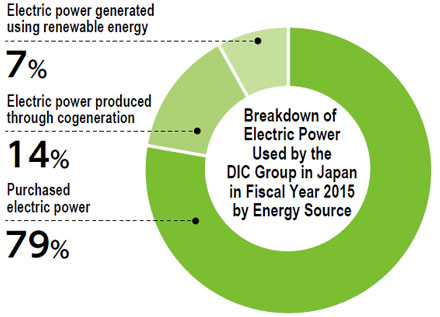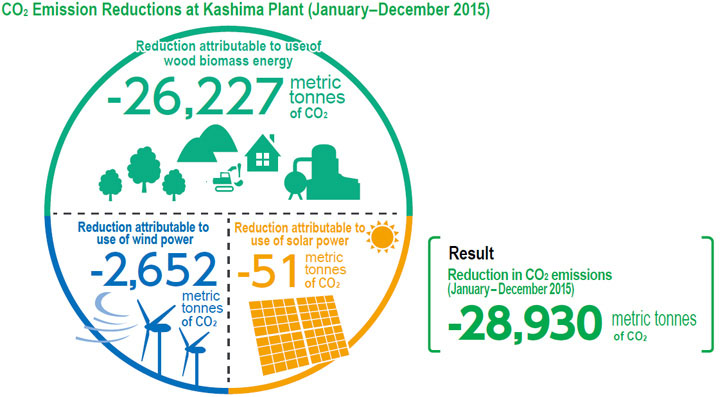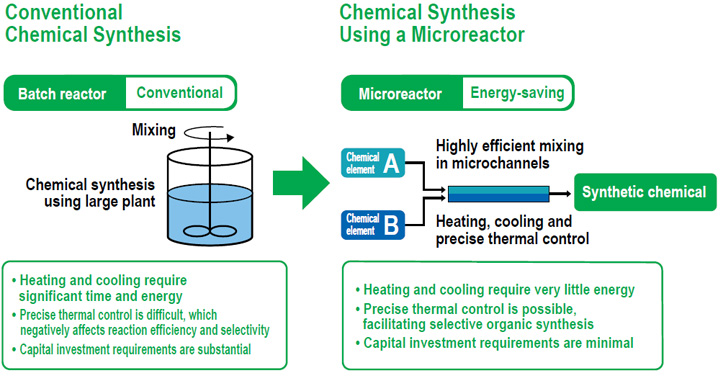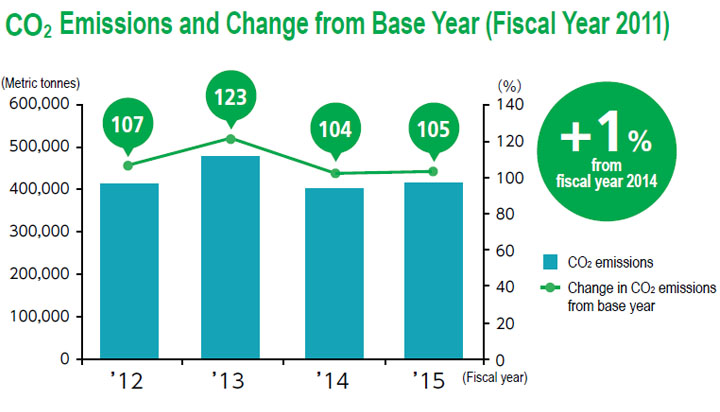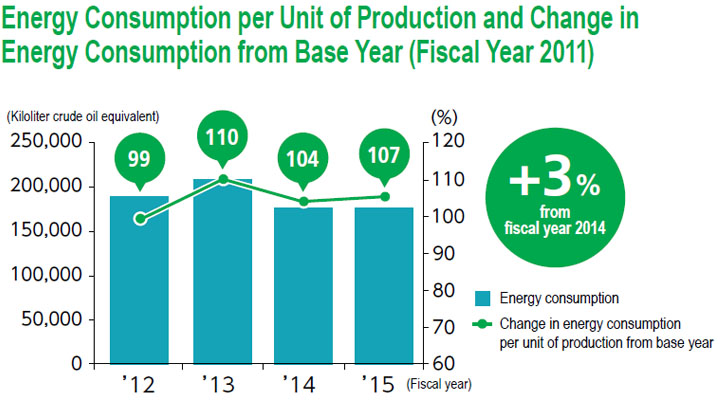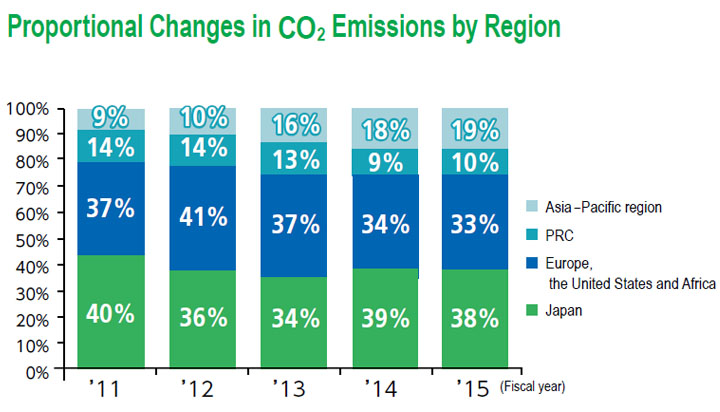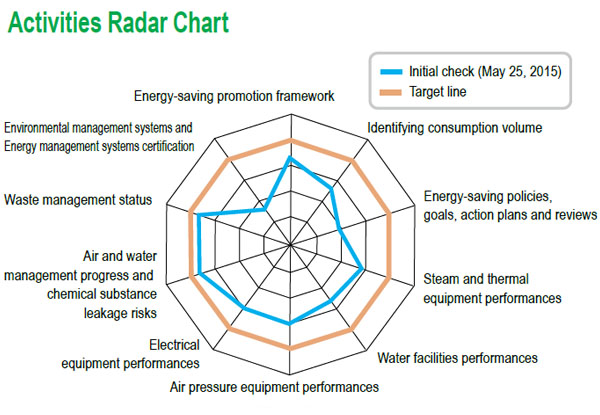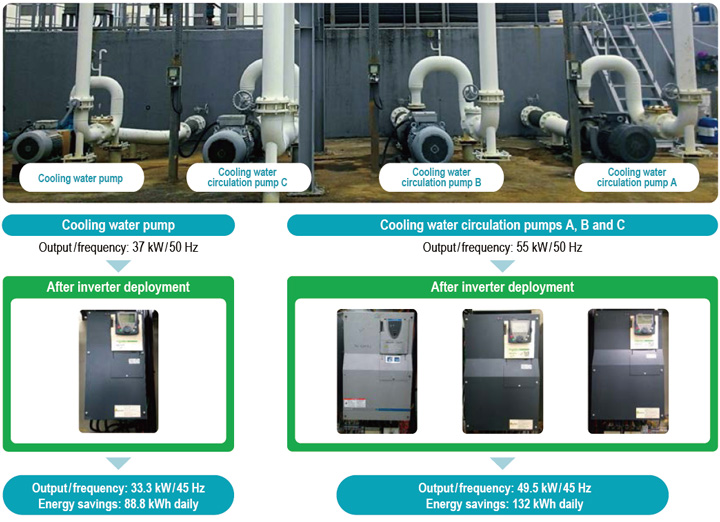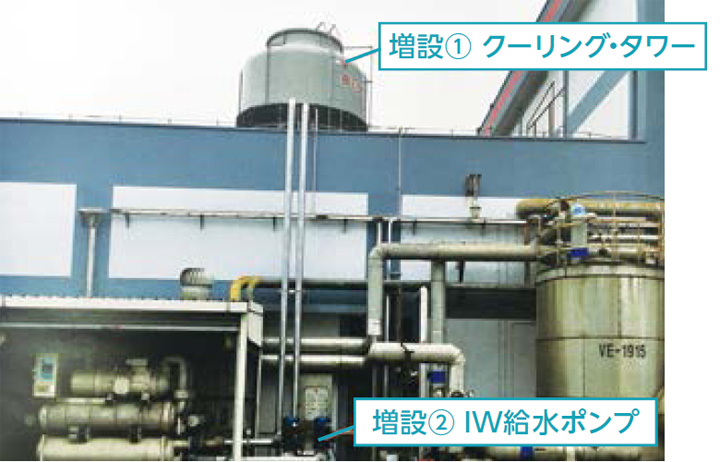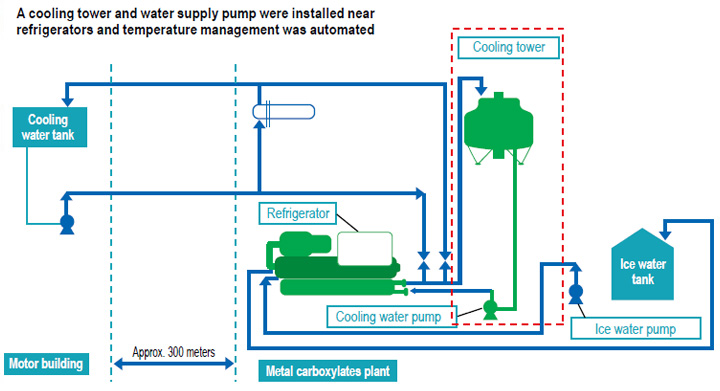Preventing Global Warming(2015)
Principal Initiatives in Fiscal Year 2015
-
Energy Consumption and CO₂ Emissions by the Global DIC Group
The DIC Group views energy consumption per metric tonne of production as an important measure of its energy effciency. In line with a 2.0% decline in production volume from a year earlier, the Group reduced energy consumption in fscal year 2015 by 1.0%, calculated in kiloliters of crude oil. This amounted to 285,557 kiloliters, from 288,452 kiloliters a year earlier. Energy consumption per unit of production rose 1.0%, to 149.89 liters/metric tonne, from 148.40 liters/metric tonne in fscal year 2014. The changes refected lower volumes for printing inks and polymers and higher production volumes for pigments and PPS products. Another factor was increased energy consumption not contributing to production, notably from the expansion of foor space in clean rooms to support quality improvement efforts. CO₂ emissions were 657,152 metric tonnes, down from 657,457 metric tonnes in fscal year 2014.
The DIC Group will continue to roll out fuel conversion and high-efficiency equipment and revamp processes and improve capacity utilization. In fscal year 2015, the Group began identifying and incorporating energy consumption and CO₂ emissions at 21 Group offces and research facilities in Japan. (Coverage was previously limited to the Central Research Laboratories and offces and research facilities within plant sites, which accounted for 1.1% of domestic energy consumption and CO₂ emissions in fscal year 2014.) Calculated on the same basis as in fscal year 2014, energy consumption per unit of production by the DIC Group in Japan in fscal year 2015 was up 0.6% from the previous period, while CO₂ emissions, at 654,457 metric tonnes, were down 0.5%. -
Energy Consumption and CO₂ Emissions by the DIC Group in Japan
The DIC Group in Japan—which encompasses DIC and the 54 business sites of its domestic Group companies—reported a 1.5% decrease in production volume and a 2.6% decline in energy consumption. This was equivalent to 108,962 kiloliters of crude oil, and refected extensive energy-saving efforts. The Group thus reached all of its targets for the year, as energy consumption per unit of production improved 1.1%, while CO₂ emissions were down 2.4%.
In fscal year 2015, the Group began identifying and incorporating energy consumption and CO₂ emissions at 21 Group offces and research facilities in Japan. (Coverage was previously limited to the Central Research Laboratories and offces and research facilities within plant sites, which accounted for 1.1% of domestic energy consumption and CO₂ emissions in fscal year 2014.) Calculated on the same basis as in fscal year 2014, energy consumption per unit of production by the DIC Group was down 2.2% from the previous period, while CO₂ emissions per unit of production declined 3.4%.Factors Contributing to Increase in CO₂ Emissions by the DIC Group in Japan in Fiscal Year 2015
Factor Impact on CO₂ emissions (metric tonnes) Change in weight* Notes Impact of energy-saving initiatives -5,592 -2.2% The implementation of 493 energy-saving initiatives accounted for a 2,506-kiloliter reduction in energy consumption. Reduction of production volume -3,738 -1.5% Production volume at DIC and domestic affliates dropped 0.9% and 2.8%, respectively, from the previous year. Change in CO₂ emissions factor for electric power purchased -3,292 -1.3% The national average of CO₂ emissions from purchased electric power increased around 2% from the previous year. In particular, there was a 5% improvement in emissions at Tokyo Electric Power Co., Inc., which was the source of 56% of the energy that the domestic DIC Group consumed. Reduced operation of biomass boilers and others 7,323 2.9% Increased maintenance of biomass boilers boosted the use of backup boilers that used fossil fuels. Additional inclusion of energy consumption at 21 offces and research facilities 2,689 1.1% Previously identifed and incorporated Central Research Laboratories and offces and research facilities within plant sites, and newly added 21 sites. CO₂ emissions from non-energy sources 1,615 0.6% Increased boiler combustion volumes from oil byproducts of production processes. Boundary changes -3,100 -1.2% Excluded from scope (11,000 metric tonnes of CO₂)→ Fuji Label Co., Ltd. and DIC Filtec, Inc.
Included in scope (7,900 metric tonnes of CO₂)→ KJ Chemicals CorporationOthers -1,958 -0.8% Reduction factor → Change in composition of production items and others
Increase factor → Increase in energy consumption that did not contribute to production, notably extended clean room foor spaceTotal -6,053 -2.4% - Increase or decrease in percentage of total CO₂ emissions from fscal year 2014
-
Energy-Saving Initiatives in Japan in Fiscal Year 2015
All plants and R&D sites endeavor to conserve energy through the following initiatives to reduce base load energy consumption and by applying the PDCA cycle to improve the effciency of production methods, thereby reducing energy used, as well as to shorten process times.
- Employ highly effcient lighting and air conditioning and measures to cut waste
- Introduce energy-saving controls on pumps and blowers
- Use more effcient compressors and implement measures to reduce pressure losses
- Promote measures to improve the power factors of electric equipment
- dopt high coeffcient of performance (COP) chillers and measures to prevent cold and hot water supply waste
- Reduce boiler fuel through the recovery of waste heat
- Ensure appropriate warming times and temperatures for raw materials
In fscal year 2015, these initiatives reduced energy consumption by 2,506 kiloliters (crude oil equivalent, with an associated reduction in CO₂ emissions of 5,592 metric tonnes), equivalent to 12,530 200-liter drums of crude oil, or 2.2% of total energy consumption by the DIC Group in Japan in the period.
While continuing to promote energy-saving measures, the Group will focus on sharing excellent practices among sites. The Group will also reinforce management manuals for key energy-consuming equipment, including boilers, chillers and compressors, to optimize performances, and step up initiatives both in Japan and overseas.The DIC Group in Japan implemented the following key energy-saving initiatives in Japan in fscal year 2015.
No Plant Energy-saving initiative Impact in fiscal year 2015 Reduction in annualenergy consumption(kiloliters) Reduction in CO2emissions (metric tonnes) 1 Yokkaichi Plant (DIC) Reduced LNG consumption by improving usage of reactionary heating medium 158 303 2 Utsunomiya Plant (DIC Graphics) Shortened operating times of cooling water pumps and air conditioners 152 275 3 Chiba Plant (DIC) Reduced steam by reinforcing heat-retention management of product tanks 151 903 4 Komaki Plant (DIC) Reduced steam losses by repairing steam pipework 126 252 5 Gunma Plant (DIC Graphics) Changed electric heating temperature settingsand shut equipment off when not in use 109 220 6 Chiba Plant (DIC) Conserved energy by upgrading P8 boiler and P12 chiller 99 200 7 Hokkaido Plant (DIC Kitanihon Polymer Co., Ltd.) Reduced boiler fuel usage by reducing usage of ash water 84 196 8 Iwai Plant (DIC, Seiko PMC Corporation) Used turpentine oil effectively as boiler fuel 65 124 9 Tatebayashi Plant (DIC) Optimized cooling water pumps and adjusted equipment operation 61 120 10 Sakai Plant (DIC) Upgraded air conditioning systems on the second and third floors of the No. 1 building (GHP → EHP) 37 70 11 Hokuriku Plant (DIC) Reduced operating times for nitrogen generation devices by 95% 31 77 12 Yatsushiro Plant (KJ Chemicals Corporation) Installed electric water heaters for baths 30 70 13 Saitama Plant (DIC) Recovered steam from waste heat boiler 30 11 14 Harima Plant (DIC, Seiko PMC) Upgraded spot coolers 26 53 15 Kansai Plant (DIC Graphics) Reduced rolling mill power consumption by employing roll-free facilities 20 40 16 Kashima Plant (DIC) Power reduction by changing technique used to remove suspended solids 19 40 17 Sodegaura Plant (DIC EP Corp.) Reduced electricity use by production plant lines 13 27 Subtotal (17 initiatives) 1,211 2,981 Others (476 initiatives) 1,295 2,611 Total (493 initiatives) 2,506 5,592 Improving Yields by Expanding Use of System to Enhance the Visibility of Energy Consumption
With the aim of optimizing the use of electric power on an individual facility basis, DIC developed a system that measures, monitors and verifes waste and irregularities in use, thereby enhancing the visibility of energy consumption. Initially installed at the Hokuriku Plant in 2012, the system—which won the ECCJ Chairman’s Prize at Japan’s 2012 Energy Conservation Grand Prize awards, sponsored by the Energy Conservation Center, Japan (ECCJ)—has since been rolled out at DIC sites across Japan. In fscal year 2014, the system was installed at the Komaki Plant. A system to enhance visibility, which also analyzes energy consumption during different production processes, was installed on the V, C and B production foors of the Chiba, Kashima and Sakai plants, respectively, to reproduce optimum yields for materials inputs. In 2016, DIC looks to install more advanced versions of the system at the Yokkaichi Plant.
One outcome of efforts to enhance the visibility of energy consumption was an increase in the number of categories of Scope 3*, in which DIC reports indirect emissions of CO₂, from one (“upstream transportation and distribution”) in fscal year 2012 to six (including “capital goods” and “waste from businesses”) in fiscal year 2013.- cope 3 is the Greenhouse Gas Protocol’s standard for calculating indirect greenhouse gas emissions resulting from production, transport, business travel and commuting, among others, across entire supply chains.
Reducing Energy Consumption and Increasing Product Quality through Kaizen Skill Improvement Training
Having recognized that enhancing the awareness of employees in production and providing them with the tools to continuously improve their work are crucial to strengthening front-line capabilities, in 2008 DIC began offering the Kaizen Skill Improvement Training program. This program—which is structured around four themes, namely, reducing energy consumption, increasing yields, enhancing product quality and rationalizing operation—seeks to foster professionals who can identify and resolve issues on their own initiative. Participants spend one year participating in initiatives aimed at improving quality control methods and the following year putting their fndings into practice. Each December, achievements are presented at a briefng attended by pertinent plant general managers and directors.
Since 2012, DIC has also provided training for employees who have completed the Kaizen Skill Improvement Training program to equip them with the leadership and educational skills necessary to serve as instructors for the program. As of the end of fscal year 2015, a cumulative total of 328 employees from DIC sites in Japan had completed the program, with approximately 10% subsequently going on to earn accreditation as program instructors, adding momentum to energy-saving and other initiatives. -
Increasing Independent Electric Power Generation through Cogeneration and the Use of Renewable Energy
Increasing Cogeneration System-Based Independent Electric Power Generation
With the aim of increasing energy efficiency, and as a precaution against natural disasters, the DIC Group in Japan is promoting the systematic adoption of cogeneration and the use of renewable energy, that is, energy from sources that are naturally replenished. Cogeneration systems burn fuel to drive turbines, facilitating the production of electric power and the recovery and reuse of waste heat (steam and hot water), thereby improving energy effciency.
With cogeneration systems already in operation at five domestic plants (Chiba, Shiga, Saitama, Gunma and Tokyo), in autumn 2015 DIC installed a natural gas turbine–powered cogeneration system with a capacity of 1,700 kWh at its Kashima Plant. As of December 2015, the total combined maximum generating capacity of the Group’s cogeneration systems in Japan was 21,000 kW. Electric power produced through cogeneration in fscal year 2015 amounted to 38,840,000 kWh, equivalent to 14.4% of the electric power consumed by the DIC Group in Japan during the period.
DIC plans to update the cogeneration system at its Chiba Plant, which currently has a capacity of 6,000 kWh, in late 2016. This is expected to increase the system’s generating capacity by 3,800 kWh.Using Renewable Energy
In Japan, the DIC Group actively promotes the use of energy from renewable sources at suitable sites. The biomass boiler at the Kashima Plant (generating capacity: 4,000 kW and 30 tons of steam per hour) contributes signifcantly to this effort. DIC focuses on improving the quality of wood chips used as boiler fuel, which infuences operating rates, as well as on enhancing maintenance procedures. By combining this boiler with two wind power facilities (each with a generating capacity of 2,300 kW) and a solar power generation facility (100 kW), DIC aims to achieve an optimal power mix of purchased electric power, cogeneration systems and renewable energy.
In fscal year 2015, the biomass boiler’s operating rates were reduced owing to maintenance. As a consequence, renewable energy usage volume declined 16.1% from a year earlier, to 12,524 kiloliters (11.5% of the DIC Group’s energy consumption in Japan). The Group’s CO₂ emissions in fscal year 2015 thus dropped 28,930 metric tonnes.
Leveraging biomass boiler management technologies developed in operating facilities at the Kashima Plant, in December 2017 DIC plans to install boilers at the Hokuriku Plant in Ishikawa Prefecture.Microreactors: Realizing Production Processes that Lower Environmental Impact
To date, the majority of synthetic chemicals have been produced in batch reactors, where two or more different chemical elements are combined, causing a chemical reaction, and byproducts and impurities are removed. Because heat exchange effciency is low, heating and cooling require signifcant amounts of energy. Also, precise thermal control is diffcult, as a result of which it is diffcult to manage reaction effciency and quality.
R&D aimed at addressing these challenges opened the way for microreactors, which employ a number of unique processes. With microreactors, the introduction of raw materials and the reaction and recovery of byproducts and impurities occurs in a continuous fow within microchannels that deliver superb heat exchange effciency. In addition to a signifcant reduction in energy use, microreactors facilitate precise thermal control—thereby minimizing electric power consumption and greatly improving reaction effciency and quality—and the reduction of waste. Microreactors also allow reactions and chemical synthesis processes that are unfeasible with batch tank reactors due to safety concerns, the benefts of which include shorter lead times for plant construction.
Having recognized the potential of microreactors early on, DIC has promoted extensive R&D aimed at developing a commercially viable unit. In September 2013, the Company’s Hokuriku Plant deployed a microreactor for use in the production process for fuorinated surfactants, achieving a signifcant improvement in reaction effciency that reduced production time to one-ninth the previous level, thereby reducing energy consumption and essentially eliminating the generation of waste during production.
Because it develops and produces a diverse range of chemical compounds, DIC prioritizes revolutionizing manufacturing processes to enhance the quality of its products and lower its impact on the environment. DIC will continue to realize production processes with low environmental impacts that contribute to its sustainability.Reconstruction of Global Corporate Headquarters
In May 2015, DIC completed a two-year reconstruction of its corporate headquarters, the DIC Building in Tokyo’s Nihonbashi district, undertaken with the aim of centralizing headquarters functions and improving the building’s environmental effciency.
- Floor space: 19,590 square meters (12 foors above ground and four below)
- Number of employees: 1,230
Environmental effciency: CASBEE* Environmental Effciency Assessment (Class S)
- The Comprehensive Assessment System for Built Environment Effciency (CASBEE) has fve certifcation levels: Class S (excellent), Class A (very good), Class B+ (good), Class B- (slightly poor) and Class C (poor).
Key Environmental Effciencies
- CO₂ emissions from building operations at time of basic design: 43.3% (1,089 metric tonnes of CO₂ a year) lower than the baseline of Tokyo Metropolitan Government’s Energy Effciency Carte
- High-effciency transformers and solar power generation facilities (50 kW) and storage batteries (100 Ah)
- Lighting: Highly effcient LED grid lighting, Ecolumi LED and automatic dimming control system
- Air conditioning: Natural ventilation and distributed control system through high-efficiency electric heat source, air-cooled heat pump air conditioner
- CO₂ control ventilation system used for underground car park
- Building energy management system used to conserve power
- Rain and groundwater used to irrigate rooftop greenery and supply all toilets in the building
Energy consumption by DIC’s corporate headquarters in fscal year 2015 was equivalent to 479 kiloliters of crude oil, a decline of 2% from fscal year 2014, despite a 23% increase in foor space.
In fscal year 2015, the building maintenance company and DIC’s Production Management Department and General Affairs and HR Department created an energy-saving promotion framework, encouraging employees to turn off lighting and air conditioning when not in use. -
Energy Consumption and CO₂ Emissions by the DIC Group Overseas
Despite a 2.4% decrease in production volume, energy consumption by DIC Group companies overseas in fscal year 2015 was level at 176,594 kiloliters of crude oil equivalent, while CO₂ emissions rose 1.4%, to 408,091 metric tonnes. The prime factors behind this were surging pigment production in Indonesia and higher energy consumption per unit of production at sites in India, the PRC (Hainan) and Taiwan (Taipei).
-
Energy-Saving Initiatives Overseas
Laws and regulations, as well as infrastructure, differ between countries and regions. The DIC Group strives to promote energy savings and effcient operations wherever it is active and in so doing sets precedents for the global chemicals industry.
Despite a 2.4% decline in production volume and the impacts of energy-saving initiatives based on MBO, the energy consumption of DIC Group companies overseas was unchanged. Energy consumption per unit of production increased 2.5%, while CO₂ emissions rose 1.4%, to 5,748 metric tonnes. In light of these results, in fscal year 2016 DIC and DIC Group companies overseas will focus more on ways to prevent global warming through more extensive energy-saving activities, collaborating closely with DIC’s Production Management Department.Results of Energy-Saving Initiatives Overseas in Fiscal Year 2015
Region Number of initiatives Reduction in energy consumption (kl) Reduction in CO₂ emissions (metric tonnes of CO₂) Asia–Pacifiregion 47 327 760 Greater China 22 151 337 Americas and Europe 8 299 691 Total 77 777 1,788 Asia–Pacifc Region
In the Asia–Pacifc region, which accounts for 19% of the CO₂ emissions of the DIC Group, energy offcers from 19 sites in 11 countries gather biennially for a conference on energy management issues and progress with energy-saving plans. (The conference itself is an annual event held in collaboration with DIC Group companies in the PRC, with the location alternating annually between the two regions.) The fscal year 2015 conference was held in May 2015 in Jakarta, Indonesia, with 257 offcers in attendance.
The objective of the conference is to keep tabs on the energy management and conservation efforts of each company to help enhance their capabilities. Recent gatherings have encompassed vigorous discussions about rollouts of measures based on the experiences of other Group companies.
Efforts have started recently in the region to check on energy management progress and the performance of energy-consuming equipment among Group companies. As part of these efforts, site employees known as energy-saving masters confirm energy-saving promotion frameworks, assess energy consumption, formulate policies and manage goals, and evaluate the performances of key equipment. They also create radar charts to clarify strengths and weaknesses and thereby encourage improvements.Installing Inverters to Reduce Power Consumption of Cooling Water Motor by 10% (DIC Epoxy (Malaysia) Sdn. Bhd.)
High electric power consumption was an issue, as DIC Epoxy (Malaysia) uses powerful electric pumps to supply and circulate cooling water in manufacturing epoxy resin. The company’s energy-saving project focused on the use of inverters as a way to match water supply to demand and consume less electricity without compromising the efficiency of cooling devices. Six inverters were installed, reducing electricity consumption around 10% by lowering motor frequency from 50 Hz to 45 Hz.
TOPICS
DIC India Celebrates World Environment Week
The DIC Group promotes diverse ESH initiatives in countries and territories around the world. In June 2016, DIC India Ltd. held World Environment Week, a campaign featuring enthusiastic participation at all of the company’s locations and from employees of all levels. The company’s objectives in organizing the campaign include reinforcing its commitment to ongoing environmental protection, resource conservation and sustainability initiatives, as well as engaging employees in environmental initiatives and ensuring their participation. World Environment Week kicked off with an address on environmental issues by senior management and a tree planting event. Individual days were assigned specific themes and named accordingly—for example, Water Conservation Day, Energy Conservation Day and Waste Minimization Day—and diverse programs were offered, including theme-specific employee awareness training. The DIC Group applauds these and other voluntary initiatives that enhance the environmental and safety awareness of employees and recognizes the importance of such efforts in helping to realize a sustainable society.
Energy Management Instruction by DIC Production Management Department
As a part of global environmental management efforts, specialists from the Production Management Department visit production sites in Greater China and the Asia–Pacific region every year to assess progress with management systems and follow up on improvements. In fiscal year 2015, these specialists visited nine production sites—two each in Indonesia and Singapore, one in Malaysia and four in the PRC. The prime goal was to reduce CO₂ emissions through the more efficient use of energy.
P T. DIC Graphics’ pigments plant in Karawang, Indonesia, is a crucial facility that functions as the mother plant for phthalocyanine pigment (blue) ink, which is used extensively in printing inks for food packaging, as well as in paints and plastics. The facility had found it challenging to improve energy efficiency, as pigment manufacturing processes use a significant amount of thermal energy (for heating media and dry boilers) and water (for washing).
As Indonesia faces difficulties in terms of its domestic natural gas supply infrastructure and prices, DIC has to use coal for fuel in its local operations. Specialists from the Production Management Department provided guidance about a method to reinforce process management by pulverizing coal uniformly to enhance combustion efficiency. They also offered suggested management techniques that clarify numbers in purification for activated sludge treatment using bacteria. Specialists provided detailed follow-up. This included suggesting upgrades to heat pump air conditioners that harness atmospheric heat such as those in use in Singapore and Malaysia and encouraging energy conservation by optimizing air compressor pressurization.VOICE
We are rediscovering the importance of inputs and outputs.

Since becoming part of the DIC Group in 2012, we have expanded plant production capacity while lowering environmental impact by deploying advanced technologies. Still, it is important to make data transparent and extensively manage inputs and outputs to ensure that pigment production is extremely energy efficient. We will continue pursuing higher goals by ensuring that all employees understand that saving energy lowers costs.
PT. DIC Graphics (Indonesia)
Manager LT Gan
Supervisor Suhaimi MoinPRC
In 2015, the government of the PRC enacted the revised Environmental Protection Law and Air Pollution Law to strengthen oversight over air, water, soil and noise. The government also required plants above certain scales to disclose environmental information. It was against this backdrop that specialists from the Production Management Department visited four sites in the south of the country to inspect environmental management systems and to follow up on issues. The sites were DIC Graphics (Guangzhou) Ltd., Shenzhen-DIC Co., Ltd., DIC Synthetic Resins (Zhongshan) Co., Ltd., and Zhongshan DIC Colour Co., Ltd.
Most production sites in Greater China are progressing well with PDCA cycles. That said, rapid production declines at some locations and heavy energy consumption to maintain and manage clean rooms at LC materials manufacturing sites drove higher energy consumption per unit of production. These issues are to be addressed from next fiscal year.Slashing Refrigerator Power Consumption by Optimizing Equipment at DIC Synthetic Resins (Zhongshan)
Electricity bills account for high proportions of manufacturing costs, so conserving the power consumption of key facilities helps to greatly reduce expenses. At the company’s metal carboxylates plant, refrigerators account for 30% of the plant’s electricity consumption. The prime factors are cooling water supplied by remote motors and water supply pumps that operate at full capacity when refrigerators are running.
To ensure that everything performs efficiently, DIC Synthetic Resins (Zhongshan) Co., Ltd. kicked off a project in May 2015 to review processes and equipment and explore improvements. This resulted in the installation of a cooling tower and water pump near refrigerators to recirculate cooling water. The company also identified a way to link refrigerator compressors with ice water pumps, automatically turning them on when temperatures exceed 13°C and turning them off when refrigerating water drops to 9°C. Full-scale operations with the new setup, which is expected to slash annual power consumption to around 120,000 kWh, from 320,000 kWh at present,commenced in January 2016. DIC Synthetic Resins (Zhongshan) looks to recoup the facilities expansion construction costs within a year.Harnessing Residual Heat from Incinerating Waste Liquid at Resin Varnish Factory at Nantong DIC Color
Nantong DIC Color Co., Ltd. incinerates waste resin varnish at the plant. The waste gas temperature from this process reaches between 700°C and 800°C. The plant installed a heat exchanger to use this heat for showers and hot water in pigment manufacturing processes. This move has cut the facility’s annual electricity bill by around Rmb168,000. The plant is pushing ahead with an in-house suggestion system to solicit further energy-saving ideas from all employees.
VOICE
Local executives play a key role in ensuring the effcient promotion of improvements.

Providing guidance in Greater China and the Asia–Pacifc region involved not only energy managers but also local executives who are vital for decision making on capital expenditure and those overseeing machinery. This was crucial because despite rigorous efforts to switch off machinery when not in use, facilities continued to incur huge costs because they kept using older machinery. Although upgrades are expensive, we sought understanding by using case studies to highlight ways in which energy-saving efforts elsewhere have led directly to cost savings.
Simply increasing the visibility of energy consumption by installing a meter made it much easier to encourage energy and cost reductions. In that there are many small ways to enhance effciency at production sites, we intend to continue identifying more improvements by providing energy-saving analyses while enhancing the skillsets of key local executives.Manager in charge of efficiency,
Production Management Department
Kazuo KawaguchiAmericas and Europe
In October 2013, the Sun Chemical Group—which has operations in 13 countries in North, Central and South America and 43 countries in Europe—rolled out a new internal Web-based data collecting system called EcoTrack, which facilitates the collection and centralized monitoring of data for key sustainability metrics related to energy, water, waste and safety at 153 sites. In addition to increasing the transparency of site data related to production, energy-saving initiatives and CO₂ emissions, among others, EcoTrack was designed to encourage the sharing of information and the horizontal deployment of measures.
The full implementation of the system across the Sun Chemical Group in fiscal year 2014 greatly increased the transparency of crucial data, which in turn accelerated the cycle of analyzing data, formulating responses and deploying measures, significantly increasing the progress of energy-saving initiatives. Of particular note, the mounting of sensors on production equipment and analysis of resulting data facilitated the calculation of optimum electric power and operating times for individual processes.
In Europe, the Sun Chemical Group continued to actively promote the use of renewable energy. In fiscal year 2015, Sun Chemical Group facilities in Europe used 900,000 kWh of renewable energy, 78% of which was accounted for by wind power and 22% by solar power, which supported the reduction of energy consumption and CO₂ emissions. -
Reducing Greenhouse Gas Emissions Attributable to Logistics
In fscal year 2015, the DIC Group continued to examine its upstream distribution bases to identify those with low efficiency levels and implemented measures aimed at improving transport options for relatively short distances. Despite these efforts, energy consumption in logistics edged up 0.3% and associated CO₂ emissions rose 3.0% against a 1.9% increase in transport volume. The principal factor behind these increases is the revision of the reporting boundary for Scope 3 emissions attributable to the transport and shipping of products. DIC also reported an 18.8% decline in the volume of products shipped using modes of transport qualifying as “modal shift.” The volume of products shipped by container ship and rail decreased 17.9% and 19.6%, respectively. Factors behind these declines included elimination of key sea routes previously used by the Company and a decrease in the number of rail containers in certain areas. The DIC Group’s modal shift rate in fscal year 2015 was 8.5%, down from 10.7% in the preceding period.
-
Initiatives in Areas Other than Production
In fscal year 2015, DIC once again promoted efforts in line with Japan’s Cool Biz and Warm Biz campaigns, offcial efforts to reduce electric power consumption by limiting the use of air conditioning in summer and winter through measures such as the introduction of more relaxed offce dress codes. The Company also continued to promote efforts aimed at reinforcing employees’ awareness of the importance of lowering energy consumption, including replacing superannuated light fxtures and air conditioning equipment in offces and sites with newer, high-effciency models that satisfy standards set by the ECCJ for its Top Runner program, turning off lights when not needed and implementing mandatory 22°C winter and 28°C summer air conditioning settings.
-
Reporting to the CDP
The CDP (formerly the Carbon Disclosure Project) is a global nonprofit organization (NPO) that works on behalf of institutional investors to motivate companies to disclose information on initiatives to combat climate change and key environmental data. The CDP analyzes and evaluates information reported by approximately 6,000 companies worldwide, including 500 in Japan, and communicates its findings to said institutional investors. DIC has been reporting to the CDP since 2010. The CDP has recognized the Company’s consistent environmental initiatives and in fiscal year 2015 awarded it an overall score of 98A- (98 points for disclosure and a performance class of A-), significantly exceeding the average for companies based in Japan, which was 86C.
VOICE
We are promoting energy conservation with the aim of achieving a balance between corporate growth and sustainability.

The adoption of the Paris Agreement at COP21 in December 2012 was a historical milestone. Under the agreement, emerging economies are also required to implement measures to combat global warming. As a consequence, we have seen a tightening of regulations governing greenhouse gas emissions in many countries and regions. Our new medium-term management plan, DIC108, positions “low carbonization” as a crucial theme to respond to social imperatives going forward. We will continue to implement initiatives aimed at ensuring that employees of the global DIC Group recognize the importance of energy conservation to our ability to achieve a balance between corporate growth and sustainability and at motivating them to achieve the targets that have been set.
General Manager,
Production Management Department
Michio UchiyamaLooking Ahead
With the goal of deepening understanding of the importance of energy effciency across the Group, DIC has inaugurated a number of important new initiatives. In Japan, for example, the Company has created a forum for DIC Group energy offcers at principal production facilities to meet regularly and established four key themes to guide the efforts of working groups: promote energy conservation (maintain or improve wastewater treatment facilities); advance joint purchasing of energy on a regional basis (capitalize on the liberalization of electric power and gas industries); enhance electrical technologies to eliminate problems arising from electrical issues; and improve the performance of power systems. Through efforts implemented in line with these themes, the Group will probe deeper into issues of concern to society and foster experts in key areas to further reinforce responsiveness Groupwide.
On another front, DIC will continue to promote awareness among the management of overseas Group companies, including by conducting seminars on the importance of addressing critical-related ESG issues. By stepping up such efforts, DIC aims to enhance the Group’s environmental performance both in Japan and overseas.
Back number
- Principal Initiatives in Fiscal Year 2023
- Principal Initiatives in Fiscal Year 2022
- Principal Initiatives in Fiscal Year 2021
- Principal Initiatives in Fiscal Year 2020
- Principal Initiatives in Fiscal Year 2019
- Principal Initiatives in Fiscal Year 2018
- Principal Initiatives in Fiscal Year 2017
- Principal Initiatives in Fiscal Year 2016
- Principal Initiatives in Fiscal Year 2015
- Principal Initiatives in Fiscal Year 2014
- Principal Initiatives in Fiscal Year 2013

